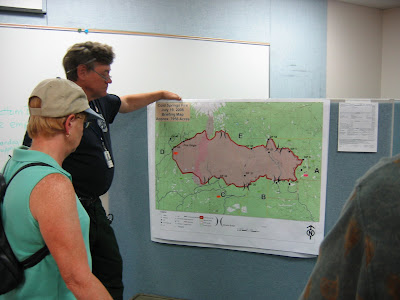Cold Springs Fire Update: Weekend & Fire Camp Tour
Saturday
Sunday
By the weekend the vast firefighting crew was winning the battle. And while the fire did occur relatively close to us (7-8 miles), it never really threatened us. The winds blew the fire primarily east, and not only were we located directly south but there were also a fair number of large irrigated fields between us and the burn zone. Still, no one likes a fire near them - particularly someone with a forest. We don't enjoy thunderstorms and their associated lightning strikes quite as much as we used to when we were renters. I guess that's just one of the downsides of owning your own place.| Acres: | 7956 |
| Containment: | 50% |
| Firefighters: | 1086 |
Sunday
| Acres: | 7956 |
| Containment: | 60% |
| Firefighters: | 1128 |
The school had become the headquarters for all of the 1000+ firefighting crew. There were tents covering the lawns and numerous trailers, trucks and other paraphernalia. Signs had been put around the school instructing people not to stop along the road to look since it could create a hazard. However, on Saturday we noticed a sign indicating that they were now giving guided tours of the fire camp! Being the engineers that we are, we were curious about some of the logistical aspects associated with fighting a fire of this size, so we signed up.
 Our tour started at 3pm on Sunday. Since the majority of the crew were up on the mountain actively battling the fire, those who remained in the camp and were conducting the tour were members of the enormous support staff that is required to provide for that many people. After a quick overview of one of the fire trucks, we moved to the supply area containing pallets full of protective clothing and gear.
Our tour started at 3pm on Sunday. Since the majority of the crew were up on the mountain actively battling the fire, those who remained in the camp and were conducting the tour were members of the enormous support staff that is required to provide for that many people. After a quick overview of one of the fire trucks, we moved to the supply area containing pallets full of protective clothing and gear. A sawyer showed us the contents of the standard 40-pound pack that each firefighter carries with him. That pack doesn't include containers for potable water, chainsaw, or chainsaw gas/oil, either - those are additional weight!
A sawyer showed us the contents of the standard 40-pound pack that each firefighter carries with him. That pack doesn't include containers for potable water, chainsaw, or chainsaw gas/oil, either - those are additional weight!We got a demonstration of how to use the protective foil "pouch" that a firefighter can use for protection if they are overtaken by fire. Once inside, the foil can deflect the worst of the heat and protect the occupant from the high temperatures. Since there is no way to detect if it is safe to exit once inside, the occupant must remain under the protection until another firefighter gives him the "all clear". Apparently studies have shown that the human body can withstand temperatures in the 300-400° range for short periods of time, but I wouldn't want to be the one to test that.
 From here we moved to a room in the school that was being used as a medical center. In here there was also a map of where each of the 5 divisions (A through E) fighting the fire were stationed, along with sticky notes indicating where each medic was.
From here we moved to a room in the school that was being used as a medical center. In here there was also a map of where each of the 5 divisions (A through E) fighting the fire were stationed, along with sticky notes indicating where each medic was.The firefighters work (and often travel) in crews of 20. (Looking at the tent city, you could see that they were all set up in groups of 20.) Some crews are responsible for digging the fire lines that are used to contain the entire fire. We had assumed that they use heavy equipment to dig the lines, but no, they dig them by hand. The crew lead starts the line and digs one shovel's width and keeps going. Then next person comes behind and widens the line by another shovel's width. By the time 20 people take a pass, they have a pretty descent fire line. Apparently, they can move pretty fast this way.
During the hours when the fire fighters aren't on the mountain, they are typically either eating, showering, or sleeping. So the camp has trailers dedicated to each of the first two, and rows of tents for the latter. The food trailer operation was out of Montana. Their meals have to provide the firefighters with 6000 calories/day. Here is the breakfast menu for the day we visited.
The firefighters we spoke to claimed to be adrenaline junkies. Even so, I can't imagine why anyone would want to do this for a job, but I sure am glad that there are people who do!
- Mike (& Corinne)






No comments:
Post a Comment